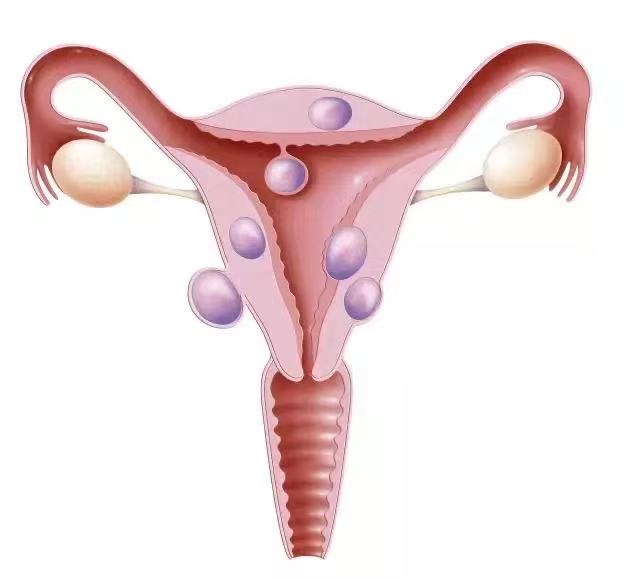| Overview Uterine fibroids are noncancerous growths of the uterus that often appear during childbearing years. Also called leiomyomas (lie-o-my-O-muhs) or myomas, uterine fibroids aren't associated with an increased risk of uterine cancer and almost never develop into cancer. Fibroids range in size from seedlings, undetectable by the human eye, to bulky masses that can distort and enlarge the uterus. You can have a single fibroid or multiple ones. In extreme cases, multiple fibroids can expand the uterus so much that it reaches the rib cage and can add weight. Symptoms Many women who have fibroids don't have any symptoms. In those that do, symptoms can be influenced by the location, size and number of fibroids. In women who have symptoms, the most common signs and symptoms of uterine fibroids include: heavy menstrual bleeding, menstrual periods lasting more than a week, pelvic pressure or pain, frequent urination, difficulty emptying the bladder, constipation, backache or leg pains. Rarely, a fibroid can cause acute pain when it outgrows its blood supply, and begins to die. |  |
Treatment
Full-term pregnancy and vaginal delivery are achievable after radiofrequency ablation of leiomyomas. However, in this interim analysis, the miscarriage rate in both radiofrequency ablation and myomectomy groups was higher than expected for women in this age group.The ULTRA (Uterine Leiomyoma Treatment With Radiofrequency Ablation) study is an ongoing multicenter prospective cohort study with longitudinal follow-up up to 5 years comparing outcomes of radiofrequency ablation with myomectomy in premenopausal women older than age 21 years with symptomatic uterine leiomyomas. Participants were queried every 6 months after surgery to assess the incidence of pregnancy and pregnancy outcomes. Among 539 women enrolled in ULTRA, a total of 37 participants (mean age at first pregnancy 35.0±4.7 years) conceived 43 times as of March 2023 (22 radiofrequency ablation, 21 myomectomy). The average length of follow-up time after all procedures was 2.5±1.0 years. The baseline miscarriage rate in the study population was 33.3%. In participants who underwent radiofrequency ablation, 9 of 22 pregnancies (40.9%, 95% CI, 20.3-61.5%) ended in first-trimester miscarriage, 11 resulted in live births (50.0%, 95% CI, 29.1-70.9%), one resulted fetal death at 30 weeks of gestation, and one resulted in uterine rupture during miscarriage treatment with misoprostol 10 weeks after radiofrequency ablation. Among the live births in the radiofrequency ablation group, 45.5% were by vaginal delivery. In the myomectomy group, 9 of 21 pregnancies (42.9%, 95% CI, 21.7-64.0%) ended in first-trimester miscarriage and 12 resulted in live births (57.1%, 95% CI, 36.0-78.3%). There were no significant differences in the likelihood of live birth or miscarriage between the study groups.
Reference
Allen A, Schembri M, Parvataneni R, Waetjen LE, Varon S, Salamat-Saberi N, Tassone S, Williams N, Kho KA, Jacoby VL. Pregnancy Outcomes After Laparoscopic Radiofrequency Ablation of Uterine Leiomyomas Compared With Myomectomy. Obstet Gynecol. 2024 May 1;143(5):612-618. doi: 10.1097/AOG.0000000000005548. Epub 2024 Mar 1. PMID: 38422502.